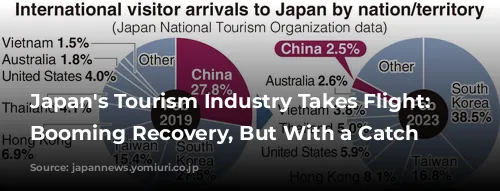After a long pandemic slumber, Japan’s tourism industry is waking up with a roar! International visitors are flocking back in droves, driven by the government’s easing of entry restrictions. The country is experiencing a much-needed economic boost, with hotels, department stores, and travel agencies seeing a surge in business. But amidst this welcome revival, a significant challenge looms on the horizon: a severe labor shortage that could dampen the industry’s enthusiasm.

Rebound on the Runway: Tourists Return, Tourism Booms
Six months after the government significantly relaxed entry restrictions into Japan, the number of international visitors is rapidly increasing. In February, the number of travelers from overseas reached more than half of the figure from the same month in 2019, before the pandemic struck. The arrival of Chinese tourists, which is expected to increase further in the coming months, will provide an even bigger boost to the industry.
The return of international travelers is evident in the bustling airports. A recent Tianjin Airlines flight arriving at Chubu Centrair International Airport marked the return of this route after a three-year hiatus due to the pandemic. Airport staff warmly welcomed passengers, eager to witness the resurgence of international travel.
One of the passengers, a Shanghai resident, shared her excitement, “I want to visit Takayama in Gifu Prefecture and buy cosmetics and a watch in Nagoya.” Her enthusiasm encapsulates the renewed vigor of the tourism industry as travelers from around the world rediscover Japan’s unique charm.
A Double-Edged Sword: Labor Shortages Cast a Shadow
While the influx of tourists is a positive sign, it’s not without its drawbacks. The hospitality industry is grappling with a severe labor shortage, a challenge that could hinder the full potential of this economic rebound. Many hotels and ryokan inns are reporting difficulties finding staff, with the shortage impacting operations and service quality.
This labor crunch stems from the pandemic, during which many younger employees left the hospitality industry to pursue opportunities in other fields. The perception of job insecurity in the hospitality sector has made it challenging to attract and retain new employees. Some businesses have resorted to utilizing gig workers, but this temporary solution is not a sustainable long-term strategy.
The government is aware of this issue and is working to address it. Tourism is a cornerstone of Japan’s economic growth strategy, and the government is committed to attracting more visitors, particularly those with higher spending power. To achieve this, the government has launched initiatives to target wealthy tourists, offering incentives for longer stays and promoting experiences in regional areas.
A Bright Future, But Challenges Remain
The return of international tourists is a promising development for Japan’s economy. But the challenges of labor shortages and ensuring a sustainable tourism model cannot be ignored. The government’s focus on attracting high-spending tourists and promoting regional destinations is a step in the right direction.
By addressing these challenges and continuing to invest in tourism infrastructure, Japan can build a thriving and sustainable tourism industry for the future. The journey to recovery has begun, and as international travelers return to Japan’s shores, the country is poised for a bright future in tourism.

